Rejected from a national exhibition, Courbet simply launched his own show to display this enormous work.
Gustave Courbet, The Painter’s Studio: A Real Allegory Summing Up Seven Years of My Life as an Artist, 1854–55, oil on canvas, 361 x 598 cm (Musée d’Orsay, Paris). Speakers: Dr. Beth Harris and Dr. Steven Zucker
A real allegory? Courbet’s contradiction
The title of Courbet’s painting contains a contradiction: the words “real” and “allegory” have opposing meanings. In Courbet’s earlier work, “real” could be seen as a rejection of the heroic and ideal in favor of the actual. Courbet’s “real” might also be a coarse and unpleasant truth, tied to economic injustice. The “real” might also point to shifting notions of morality.
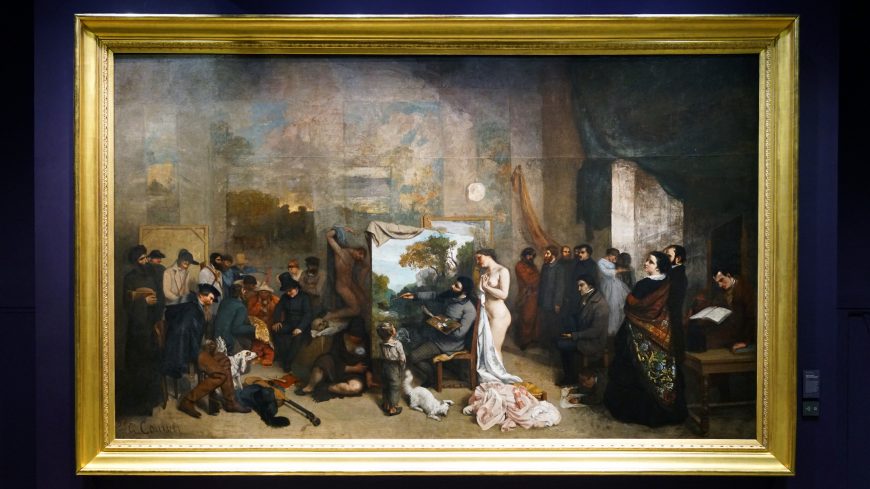
Gustave Courbet, The Painter’s Studio: A Real Allegory Summing Up Seven Years of My Life as an Artist, 1854–55, oil on canvas, 361 x 598 cm (Musée d’Orsay, Paris)
In contrast, an “allegory” is a story or an idea expressed with symbols. Is it possible that Courbet is using his title to alert the viewer to contradictions and double meanings in the image? Look, for instance, at the dim paintings that hangs on the rear wall of his Paris studio. These large landscapes seem to form a continuous horizon line from panel to panel. They dissolve enough so that we are not sure if they are paintings, or if they are perhaps windows that frame the landscape beyond. Is it “real” or is it a representation? Courbet seems to muddy the distinction and allow for both possibilities.

Gustave Courbet, La rencontre (Bonjour Monsieur Courbet), 1854, oil on canvas, 129 x 149 cm (Musée Fabre, Montpellier)
The artist
The artist is immediately recognizable in the center of the canvas. His head is cocked back and his absurd beard is thrust forward at the same haughty angle seen in Bonjour Monsieur Courbet. But here he is assessing and just possibly admiring the landscape that he is in the process of painting. The central composition is a trinity of figures (four, if you count the cat).
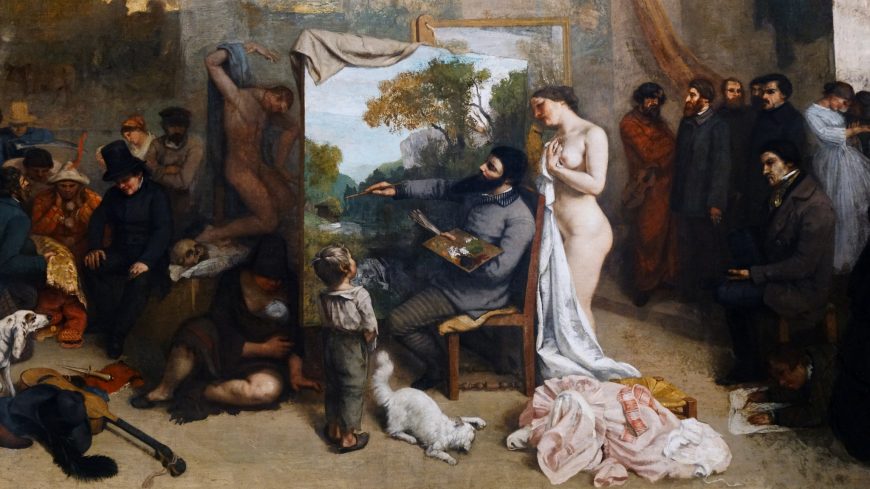
Central figures (detail), Gustave Courbet, The Painter’s Studio: A Real Allegory Summing Up Seven Years of My Life as an Artist, 1854–55, oil on canvas, 361 x 598 cm (Musée d’Orsay, Paris)
Model as muse
To Courbet’s right stands a nude model. Note that her dress is strewn at her feet. There is nothing exceptional here; after all, this is an artist’s studio, and models are often nude. However, Courbet does not look in her direction, as he would if she were actually posing for him. He doesn’t need to. He is, after all, painting an unpopulated landscape. Oddly, the direction of the gaze is reversed. The model directs her attention to align with Courbet’s, not vice-versa. She gazes at the landscape he paints. In the realm of the “real,” she functions as the model, but as “allegory,” she may be truth or liberty according to the political readings of some scholars and she may be the muse of ancient Greek myth, a symbol of Courbet’s inspiration.
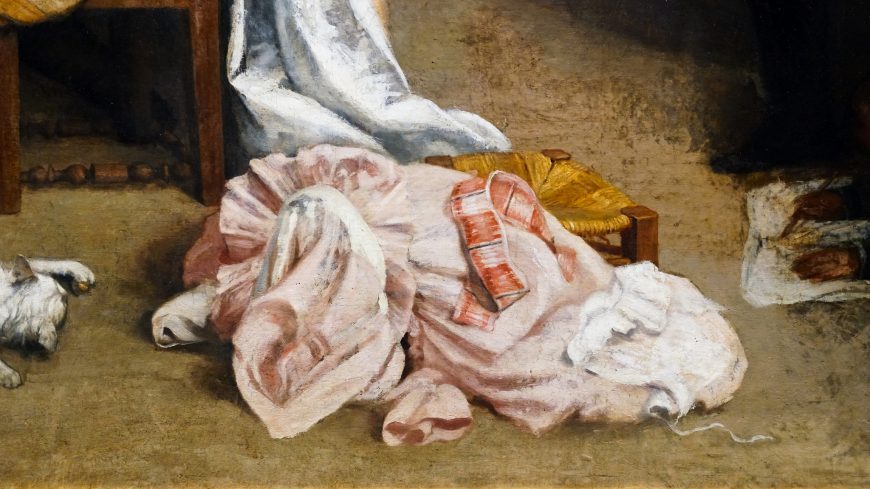
Dress (detail), Gustave Courbet, The Painter’s Studio: A Real Allegory Summing Up Seven Years of My Life as an Artist, 1854–55, oil on canvas, 361 x 598 cm (Musée d’Orsay, Paris)
Youth as innocence
The boy to the left of the artist is also a reference. The smallest of the three central figures, he looks up (literally) to Courbet’s creation with admiration. The boy is unsullied by the illusions of adulthood—he sees the truth of the world—and he represented an important goal for Courbet—to un-learn the lessons of the art academy. The sophistication of urban industrial life, he believed, distanced artists from the truth of nature. Above all, Courbet sought to return to the pure, direct sight of a child. The cat, by the way is often read as a reference to independence or liberty.
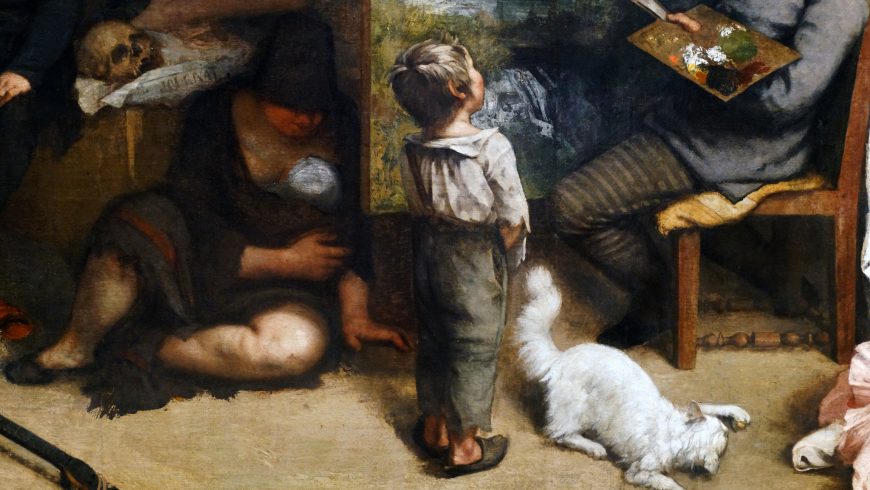
Boy (detail), Gustave Courbet, The Painter’s Studio: A Real Allegory Summing Up Seven Years of My Life as an Artist, 1854–55, oil on canvas, 361 x 598 cm (Musée d’Orsay, Paris)
Cast of characters
The entire, rather crowded canvas, is divided into two large groups of people. In the group on the left, we see fairly rough types described. They are a cast of stock characters: a woodsman, the village idiot, a Jew, and others. There are several other allusions, such as the inclusion of the current ruler of France, Louis-Napoléon, but let’s focus on the larger theme at hand. Here then, are the country folk whom Courbet faces.
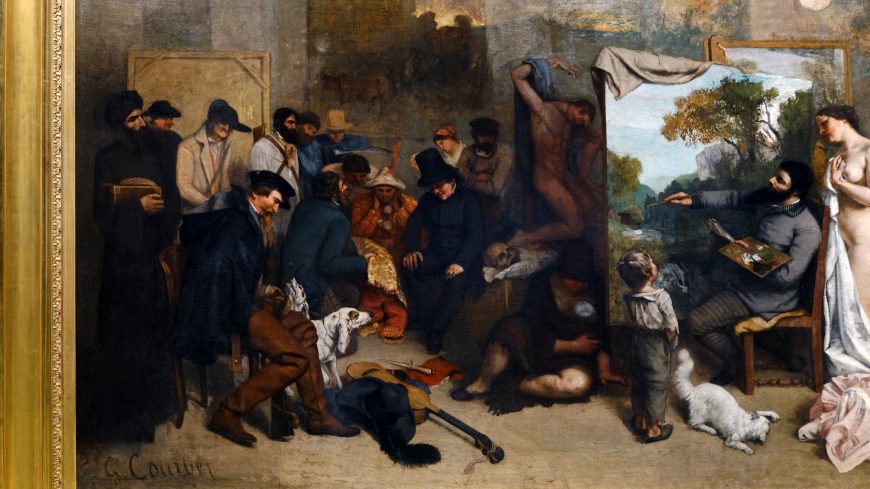
Group at left (detail), Gustave Courbet, The Painter’s Studio: A Real Allegory Summing Up Seven Years of My Life as an Artist, 1854–55, oil on canvas, 361 x 598 cm (Musée d’Orsay, Paris)
On the opposite side of the canvas are, in contrast, a far more handsome and well-dressed party. Gathered at the right lower corner of the painting are Courbet’s wealthy private collectors and his urbane friends. At the canvas’s extreme right sits Charles Baudelaire, the influential poet who was a close friend of the painter.
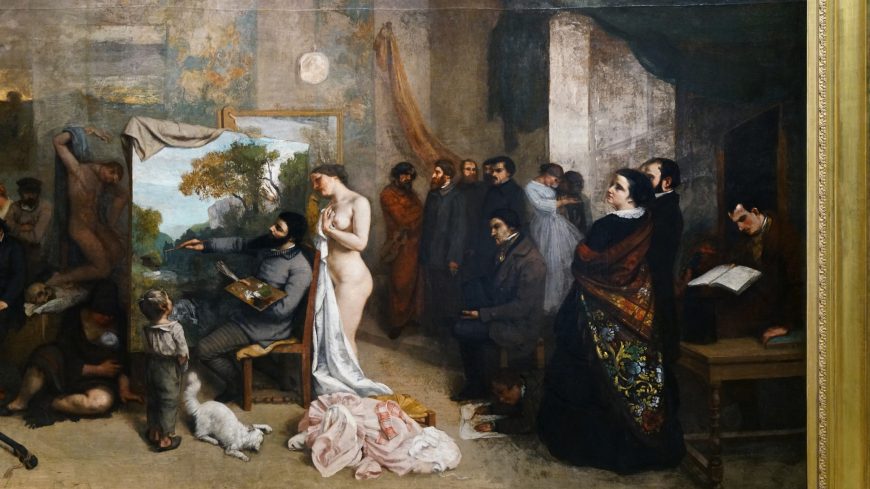
Group at right (detail), Gustave Courbet, The Painter’s Studio: A Real Allegory Summing Up Seven Years of My Life as an Artist, 1854–55, oil on canvas, 361 x 598 cm (Musée d’Orsay, Paris)
Is this composition familiar? Courbet is engaged in the act of painting, or as we might say, he is creating a landscape. Could the reference be to God the creator? The composition seems directly related to the traditional composition of the New Testament story, the Last Judgment. Think of Giotto’s Last Judgment fresco on the back wall of the Arena Chapel in Padua (1305-06), or Michelanglo’s Last Judgment painted on the altar wall of the Sistine Chapel (1534-42). In those paintings, the blessed (those that were on their way to heaven) were on the right side of Christ (our left), and the damned (those on their way to Hell) were shown on Christ’s left (our right).

Giotto, Last Judgment on the west wall, c. 1305, fresco (Arena/Scrovegni Chapel, Padua)
Courbet the creator
Courbet has placed himself in the position of creator. But does he want us to use a capital “C”? What then of the model/muse? In the place of the blessed on the left are the country folk, a reference to the morality of nature? On the right side in place of the damned are the urban sophisticates—the notion of the corruption of the city. And in the bottom right corner, where Michelangelo placed Satan himself, we find, amusingly, Courbet’s close friend, the poet Baudelaire, author of The Flowers of Evil.
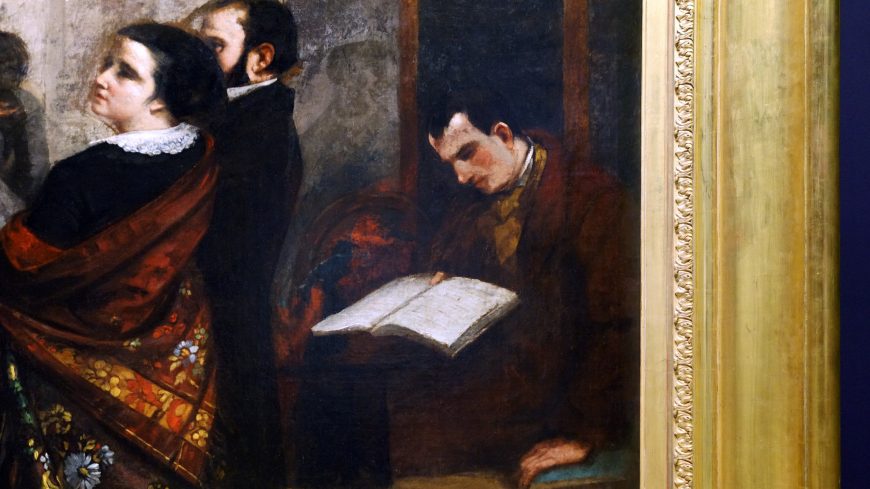
Charles Baudelaire (detail), Gustave Courbet, The Painter’s Studio: A Real Allegory Summing Up Seven Years of My Life as an Artist, 1854–55, oil on canvas, 361 x 598 cm (Musée d’Orsay, Paris)
Finally, note the crucified figure partly hidden behind the easel. Indeed, Courbet referred to himself as a kind of martyr (look at such paintings as Self-portrait as Wounded Man). He created these satirical portrayals of himself as a martyred saint perhaps because of his metaphorical “suffering” at the hands of the French art critics.
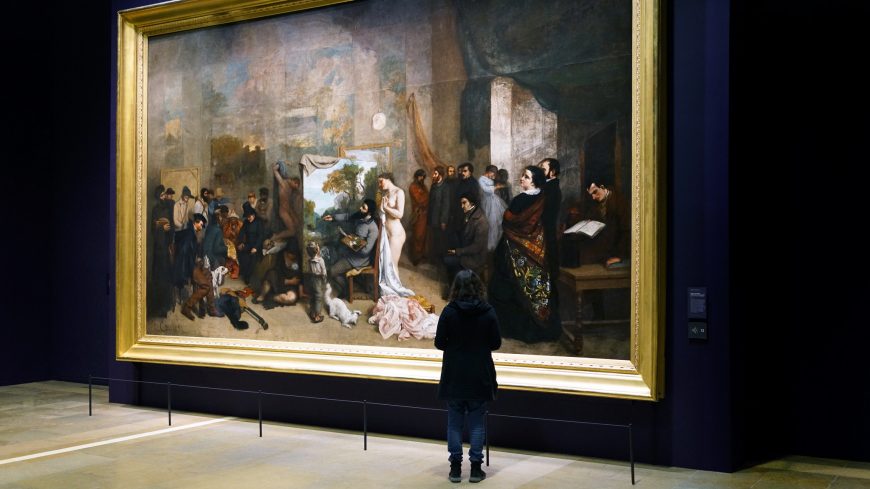
Gustave Courbet, The Painter’s Studio: A Real Allegory Summing Up Seven Years of My Life as an Artist, 1854–55, oil on canvas, 361 x 598 cm (Musée d’Orsay, Paris)
Additional resources
This painting at the Musée d’Orsay, Paris
Demonstration of Gustave Courbet’s Painting Techniques at The J. Paul Getty Museum
Smarthistory images for teaching and learning:
[flickr_tags user_id=”82032880@N00″ tags=”CourbetStudio,”]
[0:00] [music]
Dr. Steven Zucker: [0:05] We’re in the Musée d’Orsay in Paris, looking at Gustave Courbet’s enormous canvas, “The Painter’s Studio.” It has a longer title also.
Dr. Beth Harris: [0:15] “The Painter’s Studio — A Real Allegory Summing Up Seven Years of My Life as an Artist.”
Dr. Zucker: [0:21] It’s really exciting to see this painting. It’s recently been cleaned.
Dr. Harris: [0:24] There are passages that are absolutely beautiful; for example, the embroidery of the dress on the woman on the right or the discarded clothes of the model in the center. I just want to point out how large this painting is. It’s close to 12 feet tall and more than 19 feet wide. It’s important to remember that scale was an indication of importance and ambition. You might expect to see a battle scene on a painting this large.
Dr. Zucker: [0:51] I’m struck by the title because there’s a contradiction that’s built into it. It is at once a real painting — Courbet was a Realist — but the title also tells us that this is an allegory, that it is symbolic.
Dr. Harris: [1:04] How can something be real and symbolic at the same time? Yet, that is what this painting attempts to do. We should say that even after decades of art historical scholarship, there really is no consensus about what these figures symbolize, and even the Realist identity of the figures. In 1854 when the government was planning the Universal Exposition of 1855…
Dr. Zucker: [1:30] Something akin to a World’s Fair.
Dr. Harris: [1:32] Courbet was asked to submit paintings to the jury and to exhibit the paintings that were accepted at the exposition.
Dr. Zucker: [1:39] The jury would decide which paintings were admitted and which paintings were rejected.
Dr. Harris: [1:43] This was typical. This is how the Salon, the official exhibitions, worked in Paris. But the jury rejected this one and Courbet decided, in very typical Courbet fashion, “that’s OK. I’m going to set up my own exhibition.”
Dr. Zucker: [1:58] And so, as close to the exposition as he could, he set up and charged admission to see his paintings.
Dr. Harris: [2:03] He called this the “Pavilion of Realism.”
Dr. Zucker: [2:05] Let’s start with the figures at the center of this enormous canvas. We see the artist himself, Gustave Courbet. He’s dressed in a gray suit. He’s leaning back with a paintbrush in his right hand, holding a palette and additional paintbrushes in his left.
Dr. Harris: [2:19] Courbet is painting a landscape. Now, in the 19th century, landscapes were considered a lowly genre; it was those history paintings, those religious paintings that were considered important.
Dr. Zucker: [2:29] The landscape that he’s painting is a representation of the area near Ornans where Courbet grew up. Look at the way that the canvas is set so that it frames the figure of the artist himself. In back of him and looking towards the painting is a nude woman.
[2:43] The woman is understandable in the context of a studio. In more traditional paintings, we might expect to see a nude representing, for instance, the goddess of love, Venus. But here, this is clearly a modern woman. Her dress is at her feet.
Dr. Harris: [2:57] And her body appears real instead of idealized the way that an artist at this time might paint that figure of Venus.
Dr. Zucker: [3:04] She could be a muse.
Dr. Harris: [3:05] Someone who inspires his creative work.
Dr. Zucker: [3:08] And looking up at Courbet is a small child. If you look closely, you’ll notice that the child is not looking at the landscape, but is looking directly at Courbet. The child wears clogs, referencing his rural background, and his shirt is in rags. This is a figure that might remind us of Courbet’s painting “The Stone Breakers.”
Dr. Harris: [3:26] Courbet’s clearly the center of this painting, and the world revolves around him. Courbet described the figures on the right this way. “These are all the shareholders, that is, friends, workers, and art lovers.”
Dr. Zucker: [3:41] This is his world, his friends and supporters.
Dr. Harris: [3:43] For example, we see his patron, Alfred Bruyas. We also see Proudhon.
Dr. Zucker: [3:49] And like Courbet, Proudhon was a socialist.
Dr. Harris: [3:52] Politically speaking, Courbet considered himself a republican, in the sense of someone who supported the idea of France as a republic, a democracy. On the far right, we see another figure who was very important to 19th-century painting, and that’s Charles Baudelaire.
Dr. Zucker: [4:08] Baudelaire was a poet and an art critic, but he spoke very compellingly of the need for artists to turn their attention to modern life, to find beauty within the world that existed, not within the world of the past.
Dr. Harris: [4:22] That was the foundation of his idea of a realist art, not art that retold the stories of ancient Greece and Rome, but an art that was of his time.
Dr. Zucker: [4:32] And it’s crucial to understand that the definition of Realism is not naturalistic faithfulness to what one sees. It has to do with subject matter. It has to do with what is being represented. The left side of the canvas is probably the least understood.
[4:46] For quite a long time, art historians thought that the figure simply represented types of people in society. But we now know it’s actually a little more complicated.
Dr. Harris: [4:56] Courbet described them this way. He said, “This is the other world of ordinary life. The people, misery, poverty, riches, the exploited, the exploiters, those who live on death.”
Dr. Zucker: [5:07] Poverty is clear enough. Next to the small boy with ripped sleeves, we see a woman who’s nursing a child. This is an Irish woman and desperately poor.
Dr. Harris: [5:16] Above her…
Dr. Zucker: [5:17] In shadow, a skull, that potent symbol from [the] history of painting that represents the memento mori, a reminder of death.
Dr. Harris: [5:23] Seen either in a still life, as you said, as a reminder of death, or sometimes at the foot of the cross as a reference to Golgotha, where Christ was crucified.
[5:33] The figure that we see above the skull is a mannequin, a typical feature of an artist’s studio when an artist would be trying to understand how to place a figure. This figure is in the pose of the Crucifixion.
[5:47] We seem to have Courbet recalling different types of paintings; the religious painting, the genre painting with the beggar woman…
Dr. Zucker: [5:56] The still life referenced not only by the skull but also by the grouping of objects on the floor, where we see a hat, where we see a guitar, where we see a knife. As well as, as we’ve already discussed, landscape. These are all the different types of paintings.
Dr. Harris: [6:11] Then we have figures who art historians have been able to identify. For example, the prominent seated figure on the left wearing hunting boots, with hunting dogs, is a barely disguised portrait of the emperor Louis-Napoléon III.
Dr. Zucker: [6:26] Actually, the museum says a poacher — that is, somebody who hunts on land that they don’t have legal access to.
Dr. Harris: [6:32] This painting is 1855. Courbet is summing up seven years of his artistic life, that takes us back to 1848, the year of the revolution, when France was established as a republic.
[6:44] But Louis-Napoléon seized power and declared himself emperor by this time. In a way, Courbet understands him as a poacher, as someone who has taken what is not rightfully his, who has taken the government that does not belong to him but belongs to the people.
Dr. Zucker: [7:01] The figure at the extreme left is referenced as a Jew. We have a man seated in his top hat who’s referenced as an undertaker. It is these types of figures that created a degree of complexity that has bewildered art historians and viewers alike.
[7:14] This is a painting that is highly subjective. This is Courbet’s world, Courbet’s vision. Courbet is breaking the rules of 19th-century painting. He’s breaking the rules by which an artist exhibited, and in this way, is creating very important precedents for later 19th-century artists, for example, the Impressionists, who will create their own exhibition in opposition to the Salon.
Dr. Harris: [7:35] Courbet is saying to the art establishment, “painting is what I say it is, not what you say it is.”
[7:42] In fact, Courbet put this better than I can. He said, “To know in order to be able to create, that was my idea. To be in a position to translate the customs, the ideas, the appearance of my epoch, according to my own estimation. To be not only a painter but a man as well. In short, to create living art. That is my goal.”
[8:05] [music]

